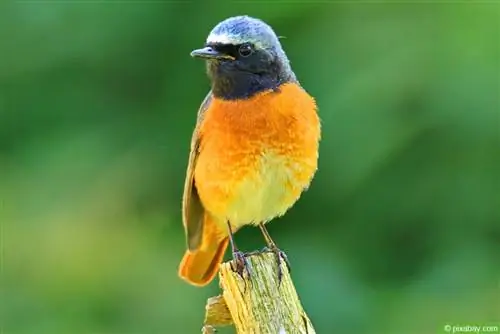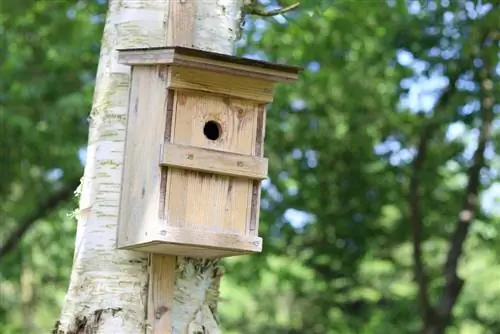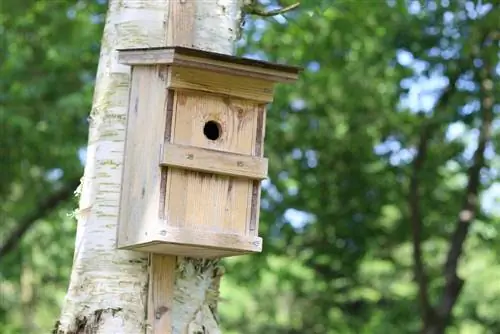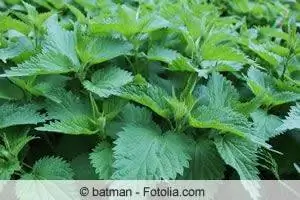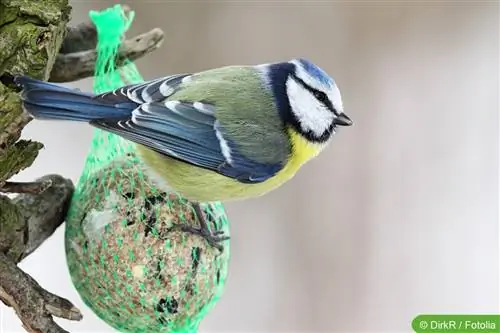- Author admin [email protected].
- Public 2023-12-17 03:39.
- Last modified 2025-01-24 12:45.
The redstart loves semi-open landscapes and sparse forests. By creating open forest structures, creating park-like landscape areas and orchards, people have created favorable habitats for redstarts over the centuries. Until the middle of the last century, it was so numerous that a handbook on ornithology described it as the most common breeding bird in Germany. However, today's landscape offers less and less space for the beautiful bird. That's why it has become rare for us.
Profile
- scientific name: Phoenicurus phoenicurus
- belongs to the genus of redstarts (Phoenicurus) within the family of flycatchers
- rare songbird species (migratory bird)
- Size: up to 14 cm
- Wingspan: up to 22 cm
- Plumage: different areas in rust red, brown and gray
- Age: 3 to 5 years
- Weight: 12-20 grams
Appearance and identifying characteristics of the redstart
The redstart was once thought to be a summer variant of the robin. Although the two birds are related to each other (both are redstarts), they otherwise look quite different. The male redstart has very contrasting colors. The head and throat are black except for a pure white stripe above the eyes that extends far back from the forehead. The chest area is colored yellow-orange to rusty red, the neck and back are gray-brown. Another distinctive feature is the brick-red tail, which gave the bird its name. Females are much more inconspicuous. The head and back are brownish, the belly and chest are light beige, sometimes with a hint of orange on the chest. Like the male, it has a brick-red tail.
Food Sources
Redstarts feed mainly on small invertebrates and insects. They only stay with us during the summer (April to August) and fly to their distant winter quarters before the start of autumn.
- Insects
- Spiders
- Butterflies
- Caterpillars (especially for breeding)
- Millipedes
- woodlice
- Annelids
- Snails
- also fruits in autumn
Food procurement
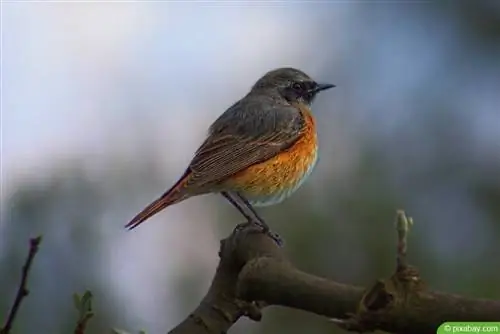
For the redstart, it is not the amount of prey in an area that is important, but good accessibility. The bird lives primarily on insects that it finds on the ground or picks up from the herbaceous layer. Sometimes he catches them in the air. The vegetation must not be too dense and bushy, but also not too sparse. In autumn, the redstart goes to its winter quarters in Central Africa (Sahel zone) early. Redstarts are not only migratory birds, but also long-distance migrants that cross the Sahara to overwinter in the savanna belt of Africa.
breeding season
From the beginning of May, the female lays around six eggs and incubates them for two weeks until the young birds hatch. After just two more weeks the young fly out. There they are fed by their parents for about a week, after which they are on their own. In warm areas, redstarts breed twice a year, but in cold areas there is rarely enough time to do so.
Nest location and nest construction
The redstart - like titmice - breeds in caves. The main selection criterion for a suitable breeding site is a relatively large opening and a location at a height of two to five meters. There the female then builds a loose nest made of dried grass, moss, roots and fibers such as feathers or hair. Preferred nesting sites:
- Tree hollows
- Rock or wall holes
- Wall ledges
- sometimes also old swallows' nests
- Nest boxes
The right nesting box for the redstart
Just offering the rare bird a nesting box is not enough to increase the population again. Only if he finds good conditions in his breeding grounds, resting places and overwintering quarters will he have good long-term chances. But everyone can make their small contribution. A good place to start is with a suitable nesting box for the redstart. Almost all cave breeding boxes that have a relatively large entry hole are accepted.
Build a nesting box
It's not difficult to build a nesting box yourself. It is important to offer the right type of nesting box. Almost all variants of a cavity breeding box are suitable; occasionally they also grow in half-cave boxes (the front wall is only half closed). Although the birds have a rather delicate body structure, they only nest in caves or nesting boxes that have a relatively large entry opening.
- Hanging height of the nesting aid: 1.5-3.5 meters
- Entrance hole: 47 millimeters diameter
- Inside nesting box dimensions (W x D x H): 140 x 140 x 250 millimeters
- Start of laying: beginning of May
Construction instructions
It's best to get a few boards made of light solid wood (fir or pine) from the hardware store. Only untreated, dry wood should be used, which after assembly is painted with an environmentally friendly glaze to make it water-repellent. The board thickness should be about 2 cm. If you're not particularly handy or don't have a saw to hand, you can have the boards cut to the right size at the hardware store. At home, all you have to do is put the individual parts together
Tip:
Only use glazes that meet the safety requirements of children's toys. Chemicals can harm birds.
Needed tools:
- Saw for the boards
- Hammer
- Drilling machine
The wooden boards can be roughened on the inside with a wire brush so that the young birds can climb up easily.
Components (dimensions: W x H):
- Back wall: 18 x 27 cm
- Front wall: 18 x 24 cm
- Floor: 18 x 18 cm
- Roof: 24 x 26 cm
- Bar: 5 x 50 cm
- 2 side walls (sloping at the top towards the front): width 22 cm, height at the back 27 cm, height at the front 24 cm
- Nails
- Closure for the front (grater, casket lock or nail crooked at right angles)
First, three holes are drilled in the ground with a 5 mm wood drill so that moisture can drain away. First the back wall is nailed to the floor, then the two side walls, and finally the roof (sloping towards the front). A hole approximately 47 millimeters in diameter must first be inserted into the front wall. The front wall is not nailed down because it should be easy to open later to clean the nesting box. It is installed so that the front can later be opened upwards. To do this, the front wall is attached to the top of the side walls between two nails. So that the nails can be turned like hinges, the side walls must first be drilled through at this point (approximately the diameter of the nail).
A rotating hook (for example a so-called grater) can be used to fix the lower side. The strip is then screwed vertically to the back wall so that approximately equal pieces protrude above and below. The nesting box is hung on the side of a tree, house wall or similar that is away from the sun and weather, at least 1.5 meters high
Tip:
Gluing or gluing the wooden parts is unfavorable as the nesting box also has to withstand extreme weather conditions.
What you need to know about redstart
- Redstarts are niche breeders.
- A distinction is made between the common redstart and the black redstart. Redstarts are much rarer.
- The breeding population has declined sharply in recent decades.
- The redstart has been added to the list of threatened bird species.
- The incubator for the redstart must have a sloping roof that overhangs to the front and sides.
- The base area of the box should be approximately 11 x 14 cm.
- The roof then has an area of 27 x 35 cm, so it is significantly larger. This is for darkening.
- The nesting box is placed at a lofty height if possible. No sun is allowed to shine into the approach hole all day long.
- The hole will face north. The entrance hole is not round, but oval or square and wide.
- A size of around 32 mm wide and 48 mm high has proven successful.
- The problem with the redstart is that it returns very late from its winter quarters, which is in the Sahara.
- Most of the nesting sites are already occupied. Special nesting boxes for the redstart should therefore only be hung from April 25th.
- The black redstart sometimes uses a semi-cavity as a nesting aid.
- Both nesting boxes, both of the redstart and the black redstart, are very threatened by cats.
- As a protective measure, attaching cat repellent belts is recommended.
- A very special, predator-proof special nesting box was developed for redstarts.

